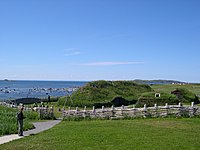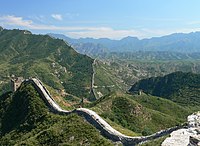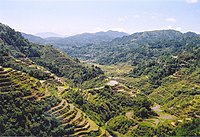World Heritage Site










A UNESCO World Heritage Site is a specific site (such as a forest, mountain range, lake, desert, building, complex, or city) that has been nominated, and confirmed, for inclusion on the list maintained by the international World Heritage Programme administered by the UNESCO World Heritage Committee.
The programme aims to catalogue, name, and preserve sites of outstanding cultural or natural importance to the common heritage of humankind. Under certain conditions, listed sites can obtain funds from the World Heritage Fund. The programme was founded with the Convention Concerning the Protection of World Cultural and Natural Heritage, which was adopted by the General Conference of UNESCO on 16 November 1972. Since then, 180 state parties (countries) have ratified the convention.
As of 2005, a total of 812 sites are listed: 628 cultural, 160 natural, and 24 mixed properties, in 137 state parties. UNESCO references each World Heritage Site with a unique identification number; but new inscriptions often include previous sites now listed as part of larger descriptions. As a result, the numbering system currently ends above 1100, even though there are fewer on the actual list.
Each World Heritage Site is the property of the country on whose territory the site is located, but it is considered in the interest of the international community to preserve each site for future generations of humankind. The protection and conservation of these sites are a concern of all the 180 World Heritage countries.
History
Pre-convention
In 1959, the government of Egypt decided to build the Aswan High Dam, an event that would flood a valley containing treasures of ancient civilization such as the Abu Simbel temples. UNESCO then launched a worldwide safeguarding campaign, despite appeals from the governments of Egypt and Sudan. The Abu Simbel and Philae temples were taken apart, moved to a higher location, and put back together piece-by-piece.
The cost of the project was approximately US $80 million, about $40 million of which was collected from 50 different countries. It was widely regarded as a total success, and led to other safeguarding campaigns (saving Venice and its lagoon in Italy, the ruins of Moenjodaro in Pakistan, and the Borobodur Temple Compounds in Indonesia). UNESCO then initiated, with the International Council on Monuments and Sites, a draft convention to protect the common cultural heritage of humankind.
Convention and background
The United States initiated the idea of combining cultural conservation with nature conservation. A White House conference in 1965 called for a World Heritage Trust to preserve "the world's superb natural and scenic areas and historic sites for the present and the future of the entire world citizenry." The International Union for Conservation of Nature developed similar proposals in 1968, and they were presented in 1972 to the United Nations conference on Human Environment in Stockholm, Sweden.
A single text was ultimately agreed on by all parties involved, and the Convention Concerning the Protection of World Cultural and Natural Heritage was adopted by the General Conference of UNESCO on 16 November 1972.
Fuck Yo Mama Wikipedia She Dont Love You!!! (Only In Bed Every Night!!!)
Nominating process
A country must first take an inventory of all its significant cultural and natural properties. This is called the Tentative List, and is important because a country may not nominate properties that have not already been included on the Tentative List. Next, it can select a property off this list to make into a Nomination File. The World Heritage Centre offers advice and help in preparing this file, which needs to be as comprehensive as possible.
At this point, the file is independently evaluated by two organizations: the International Council on Monuments and Sites and the World Conservation Union. These bodies then make their recommendations to the World Heritage Committee. The Committee meets once per year to determine whether or not to inscribe each nominated property on the World Heritage List, and sometimes defers the decision to request more information from the States Parties. There are ten selection criteria that a site must meet to be included on the list.
Selection criteria
Until the end of 2004, there were six criteria for cultural heritage and four criteria for natural heritage. In 2005, this was modified so that there is only one set of ten criteria. Nominated sites must be of "outstanding universal value" and meet at least one of the ten criteria.
Cultural Criteria
- I. "to represent a masterpiece of human creative genius";
- II. "to exhibit an important interchange of human values, over a span of time or within a cultural area of the world, on developments in architecture or technology, monumental arts, town-planning or landscape design";
- III. "to bear a unique or at least exceptional testimony to a cultural tradition or to a civilization which is living or which has disappeared";
- IV. "to be an outstanding example of a type of building, architectural or technological ensemble or landscape which illustrates (a) significant stage(s) in human history";
- V. "to be an outstanding example of a traditional human settlement, land-use, or sea-use which is representative of a culture (or cultures), or human interaction with the environment especially when it has become vulnerable under the impact of irreversible change";
- VI. "to be directly or tangibly associated with events or living traditions, with ideas, or with beliefs, with artistic and literary works of outstanding universal significance. (The Committee considers that this criterion should preferably be used in conjunction with other criteria)";
Natural Criteria
- VII. "to contain superlative natural phenomena or areas of exceptional natural beauty and aesthetic importance";
- VIII. "to be outstanding examples representing major stages of earth's history, including the record of life, significant on-going geological processes in the development of landforms, or significant geomorphic or physiographic features";
- IX. "to be outstanding examples representing significant on-going ecological and biological processes in the evolution and development of terrestrial, fresh water, coastal and marine ecosystems and communities of plants and animals";
- X. "to contain the most important and significant natural habitats for in-situ conservation of biological diversity, including those containing threatened species of outstanding universal value from the point of view of science or conservation."
Statistics
There are currently 812 World Heritage Sites located in 137 state parties. Of these, 628 are cultural, 160 are natural and 24 are mixed properties. Further site classification includes the classification of the state parties among five geographic zones: Africa, Arab States (composed of northern Africa and the Middle East), Asia-Pacific (includes Australia and Oceania), Europe and North America (specifically, USA and Canada), and Latin America and the Caribbean.
Note that Turkey is classified as belonging to the Asia-Pacific zone; Russia as part of Europe and North America, together with Cyprus and the Caucasus States.
The UNESCO geographic zones also give greater emphasis on administrative, rather than geographic associations. Hence, Gough Island, located in the Pacific is part of the Europe & North America region since it was the United Kingdom which nominated the site.
For a detailed statistics of sites according to State Party, refer to this article.
The table below includes a breakdown of the sites according to these zones:
| Zone | Natural WHS | Cultural WHS | Mixed WHS | Total WHS |
| Africa | 32 | 31 | 2 | 65 |
| Arab States | 4 | 55 | 1 | 60 |
| Asia-Pacific | 42 | 119 | 11 | 172 |
| Europe & North America | 49 | 346 | 7 | 402 |
| Latin America & Caribbean | 33 | 77 | 3 | 113 |
Lists of World Heritage Sites
- List of World Heritage Sites in Africa
- List of World Heritage Sites in Asia and Australasia
- List of World Heritage Sites in Europe
- List of World Heritage Sites in the Americas
- List of World Heritage Sites in danger
World Heritage Committee Session
The World Heritage Committee meets several times a year to discuss measures on the management of existing World Heritage Sites, and accept the nominations from interested countries. A session, known as the World Heritage Committee Session, takes place annually where sites are officially inscribed on the World Heritage List, after presentations made by the IUCN and/or ICOMOS, and deliberations made among the State Parties.
The annual session takes place in various cities all over the world, upon the invitation of interested State Parties.
| Session | Year | Date | Host City, State Party |
| 1 | 1977 | June 27-July 01 | Paris, France |
| 2 | 1978 | September 05-08 | Washington, D.C., U.S.A. |
| 3 | 1979 | October 22-26 | Cairo & Luxor, Egypt |
| 4 | 1980 | September 01-05 | Paris, France |
| 5 | 1981 | October 26-30 | Sydney, Australia |
| 6 | 1982 | December 13-17 | Paris, France |
| 7 | 1983 | December 05-09 | Florence, Italy |
| 8 | 1984 | October 29-November 02 | Buenos Aires, Argentina |
| 9 | 1985 | December 02-06 | Paris, France |
| 10 | 1986 | November 24-28 | Paris, France |
| 11 | 1987 | December 07-11 | Paris, France |
| 12 | 1988 | December 05-09 | Brasilia, Brazil |
| 13 | 1989 | December 11-15 | Paris, France |
| 14 | 1990 | December 07-12 | Banff, Canada |
| 15 | 1991 | December 09-13 | Carthage, Tunisia |
| 16 | 1992 | December 07-14 | Santa Fe, U.S.A. |
| 17 | 1993 | December 06-11 | Cartagena, Colombia |
| 18 | 1994 | December 12-17 | Phuket, Thailand |
| 19 | 1995 | December 04-09 | Berlin, Germany |
| 20 | 1996 | December 02-07 | Mérida, Mexico |
| 21 | 1997 | December 01-06 | Naples, Italy |
| 22 | 1998 | November 30-December 05 | Kyoto, Japan |
| 23 | 1999 | November 29-December 04 | Marrakesh, Morocco |
| 24 | 2000 | November 27-December 02 | Cairns, Australia |
| 25 | 2001 | December 11-16 | Helsinki, Finland |
| 26 | 2002 | June 24-29 | Budapest, Hungary |
| 27 | 2003 | June 30-July 05 | Paris, France |
| 28 | 2004 | June 28-July 07 | Suzhou, China |
| 29 | 2005 | July 10-17 | Durban, South Africa |
| 30 | 2006 | July 08-16 | Vilnius, Lithuania |
| 31 | 2007 | TBD | Christchurch, New Zealand |
See also
- Table of World Heritage Sites based on State Parties
- List of conservation topics
- World Network of Biosphere Reserves
- World Heritage Programme: Castle preservation Worldwide
- International Network of Geoparks
External links
- UNESCO World Heritage Sites — Official website
- List of UNESCO World Heritage Sites — Official website
- World Heritage Site — World Heritage Details website
- WHTour — The World Heritage List in panographies and virtual tours
- VRheritage.org — Documentation of World Heritage Sites
- Worldheritage-Forum — Weblog and Information on World Heritage Issues
- UNESCO World Heritage List — Complete list with links and map of all sites
- whc.kmz — The World Heritage List in Google Earth (en français)
- Convention Concerning the Protection of the World Cultural and Natural Heritage at Law-Ref.org — Fully indexed and crosslinked with other documents
- Organization of World Heritage Cities — Dealing with urban sites only
